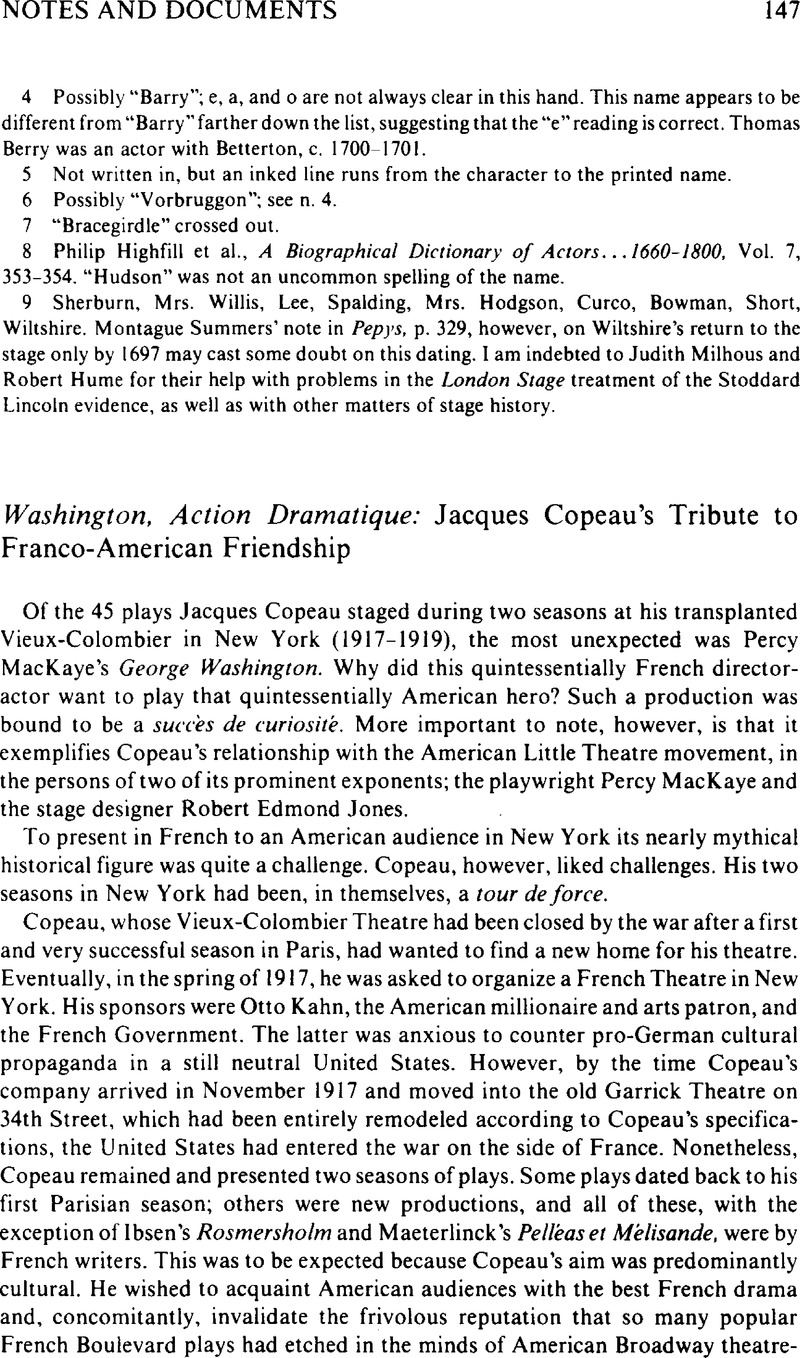No CrossRef data available.
Published online by Cambridge University Press: 07 July 2009

1 P. MacKaye to J. Copeau, December 1917. Fonds Copeau, Bibliothèque de l'Arsenal.
2 January 1918. Fonds Copeau.
3 “Stirring Our Mystic Affluence,” New Republic, 5 January 1918, 283Google Scholar.
4 Les Registres du Vieux Colombier, America, Deuxième Partie, vol. 4 of Les Registres de Jacques Copeau (Paris: Gallimard, 1984), 219Google Scholar.
5 P. MacKaye to J. Copeau, 23 March 1918. Fonds Copeau.
6 New York: Mitchell Kennerly, 1912. In Collection M. H. Dasté.
7 Catalogue de L'Exposition, no. 298 (Crayon et Lavis), 37Google Scholar.
8 Le Théâtre Populaire. (Paris: Bibliothéque de Peuple, P.U.F., 1941), 41–42Google Scholar. (Translation mine.)
9 “The New Stagecraft,” New York Times, 20 October 1918, IVGoogle Scholar.
10 Les Registres du Vieux Colombier, America, Deuxième Partie, 374–375.
11 Washington, The Man Who Made Us: A Ballad Play (New York: Alfred A. Knopf, 1919)Google Scholar. The appendix states that there are two versions: the theatre version for the commercial theatre of today and the Festival version (the published version) for the community theatre of tomorrow. The latter would hold a hundred community participants; the former (by a combination of doubling roles), only 29 professionals. Each act is divided into “actions” linked by “transitions” in the form of ballads.
12 Les Registres du Vieux Colombier, America, Deuxième Partie, 385.
13 Washington, Action dramatique, trad. de l'anglais par Pierre de Lanux (New York: Brentano's, 1919), 50Google Scholar. Pierre de Lanux was a member of the French High Commission in the United States and an experienced translator.
14 Young, Stark, “A French Theatrical Washington,” Literary Digest, 8 March 1919, 30–31Google Scholar.
15 “Percy Mackaye Tells About Putting Washington in Play,” New York Herald, 9 February 1919, IIIGoogle Scholar.
16 Herendeen, Anne, “Mackaye and Copeau, Assassins Extraordinary,” Everybody's Magazine, May 1919, 29Google Scholar.
17 “Play Shows France as Savior of U.S.,” New York Sun, 18 February 1919Google Scholar.
18 “Mr. Hornblow Goes to the Play,” Theatre Magazine, April 1919, 199.
19 “Washington Seen at French Theatre,” Brooklyn Daily Eagle, 18 February 1919Google Scholar.
20 “A French Theatrical Washington,” Literary Digest, 8 March 1919, 30–31Google Scholar.
21 “A French-American Program,” New York Times, 18 February 1919Google Scholar.
22 “Washington-Copeau,” The New France, New York, 1 March 1919, 433Google Scholar.
23 Brooklyn Daily Eagle, 18 February 1919Google Scholar.
24 Boston Evening Transcript, 19 February 1919, IIGoogle Scholar.
25 Brooklyn Daily Eagle, 18 February 1919Google Scholar.
26 Les Registres du Vieux Colombier, America, Deuxième Partie, 418.
27 Following the precedent of Copeau's version, subsequent “Dramatic Actions” were excerpted from the play and published for use in professional and amateur performances, e.g., George Washington (1920), Young Washington at Mount Vernon (1927). The theatre version of Washington, The Man Who Made Us, in three acts and a prologue, starring Walter Hampden as Washington, was given a performance at the Belasco Theatre in Washington, D.C. on 22 February 1920. It then opened at the Lyric Theatre in New York on 1 March 1920.
28 “Thoughts on the little theatres,” The American Society Legion of Honor Magazine, New York, autumn 1954, 260–264Google Scholar.